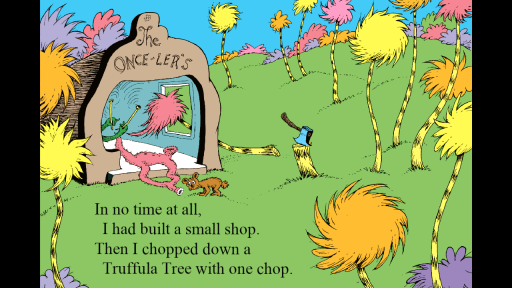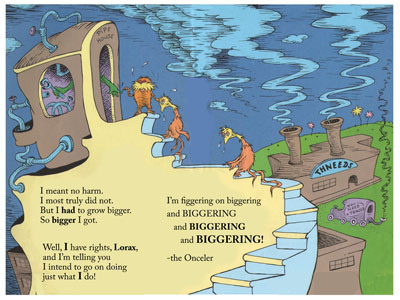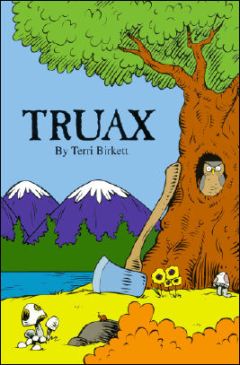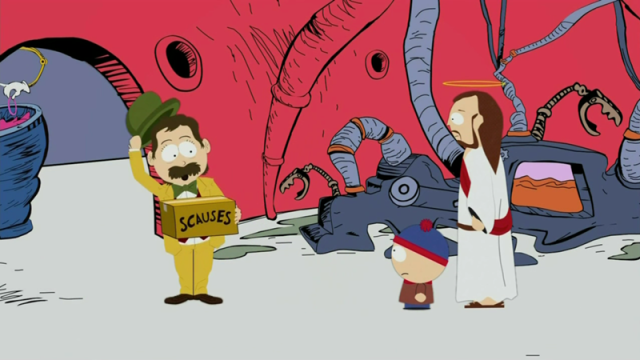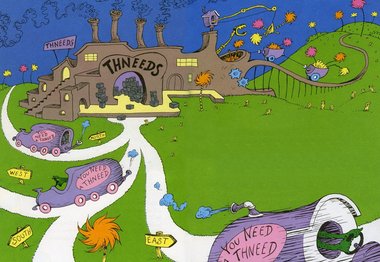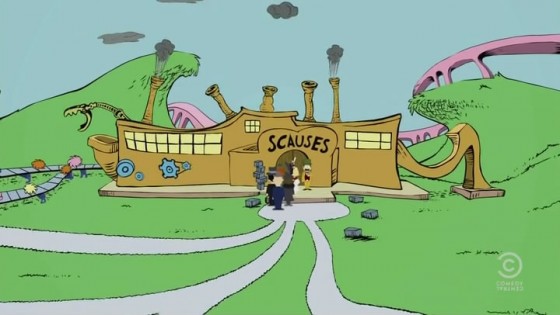Published in 1971 by Random House Inc.
SUMMARY:
It is almost a shame to try to put this story into summary form, because it is told so beautifully. It starts with a young boy wandering down a dark lane called The Street of the Lifted Lorax. We instantly feel the mystery, and the narrator furthers this feeling by asking:
“What was the Lorax?
And why was it there?
And why was it lifted and taken somewhere
from the far end of town where the Grickle-grass grows?
The old Once-ler still lives here.
Ask him. He knows.”
The Once-ler lives at the top of a tall rickety old building with boarded up windows. We can’t fully see him, just a pair of yellow eyes and green arms. To tell us the story of the Lifted Lorax, the Once-ler requires payment. He lets down a pail on the end of a string and the small boy that represents us, the audience, throws in the odd payment of “fifteen cents and a nail and the shell of a great-great-great-grandfather snail.”
After counting and hiding your payment he lets down a Whisper-ma-Phone to tell you the secrets of what happened. The pages up to this point are full of blues and purples and a touch of green. All cool colors that create a dark somber feel, but when the Once-ler starts to tell the story and takes us to “a long, long time back…” the pages become bright and happy. They now have lots of pinks, yellows and oranges mixed into sunnier greens and blues.
The Once-ler starts his story with a description to match the beautiful pages:
“Way back in the days when the grass was still green
and the pond was still wet
and the clouds were still clean,
and the song of the Swomee-Swans rang out in space…
one morning, I came to this glorious place.
And I first saw the trees!
The Truffula Trees!
The bright-colored tufts of the Truffula Trees!
Mile after mile in the fresh morning breeze.”
We then meet some of the creatures of the land. There are the Brown Bar-ba-loots that are like small playful bears. They eat the fruits of the Truffula Trees. We also meet the Humming-Fish that splash around in the fresh ponds under the Trufulla Trees, but the Once-ler is much more interested in the trees themselves. Their tufts are softer than silk and he has an idea of exactly what to do with them.
He quickly unloads his cart and builds a small shop right then and there. He chops down a Trufulla Tree and uses the tuft to knit a Thneed. Just as he finishes his work a small creature with a great yellow mustache pops out of the trunk of the chopped down tree. The Once-ler describes him:
“He was shortish. And oldish.
And brownish. And mossy.
And spoke with a voice
that was sharpish and bossy.”
The creature introduces himself,
“I am the Lorax. I speak for the trees.
I speak for the trees, for the trees have no tongues.”
He asks the Once-ler what he has made out of the tree he chopped down. The Once-ler shows him the Thneed. Apparently, the Thneed is a “Fine-Something-That-All-People-Need!” The Once-ler explains its many uses, such as being a shirt, a sock or a glove.
The Lorax is convinced that the Once-ler is just greedy and the Thneed will not sell, but at that moment someone comes and buys it. Then the Once-ler builds a radio-phone and calls in the whole Once-ler family to start business! They build a Thneed factory and start chopping down trees. Chopping down just one tree at a time was too slow so the Once-ler builds a Super-Axe-Hacker which cuts down four Truffula Trees at a time.
The Once-ler doesn’t hear from the Lorax for a week, but one day he shows up at the Once-ler’s Office door and explains that the Brow Bar-ba-loots no longer have enough Truffula Fruit to eat so they have to leave. The Once-ler gives this excuse:
“I meant no harm. I most truly did not.
But I had to grow bigger. So bigger I got.
I biggered my factory. I biggered my roads.
I biggered my wagons. I biggered the loads
of the Thneeds I shipped out. I was shipping them forth
to the South! To the East! To the West! To the North!
I went right on biggering…selling more Thneeds.
And I biggered my money, which everyone needs.”
At this point the colors of the illustrations start to change. The sky becomes duller and the clouds are polluted with blues and purples. Next, the Lorax brings the Swomee-Swans which can’t sing because of the “smogulous smoke!” So they have to fly far away to find somewhere cleaner. As they fly away we can see that the tufts of the trees close to the factory are now all grayish-purple and starting to look droopy.
The Lorax pulls the Once-ler through the Thneed factory showing the reader what the inside looks like. There are vats of slime being churned and slurped through hoses into other vats.
“Your machinery chugs on, day and night without stop
making Gluppity-Glup. Also Schloppity-Schlopp.
And what do you do with this leftover goo?…
I’ll show you. You dirty old Once-ler man, you!”
The Lorax shows the Once-ler, and the reader, the mucked up ponds where the Humming-Fish used to hum, but now they can’t because their gills are all gummed. So they walk off on their fins looking for clean water. At this point the Once-ler gets mad and yells at the Lorax, pointing his green finger right in the Lorax’s face.
“Now listen here, Dad!
All you do is yap-yap and say, ‘Bad! Bad! Bad! Bad!’
Well, I have my rights, sir, and I’m telling you
I intend to go on doing just what I do!
And, for your information, you Lorax, I’m figgering
on biggering and BIGGERING and BIGGERING and BIGGEREING,
turning MORE Trufulla Trees into Thneeds
which everyone, EVERYONE, EVERYONE needs!”
Just at that moment they hear a loud whack! The very last Truffula tree had been cut down. The whole Once-ler family leaves, because without the trees there is no more work to be done. The Once-ler is now left alone in his huge empty factory. The Lorax doesn’t even say a word. He just gives the Once-ler a sad backward glance and lifts himself up through the air and leaves through a small hole in the smog, never to return.
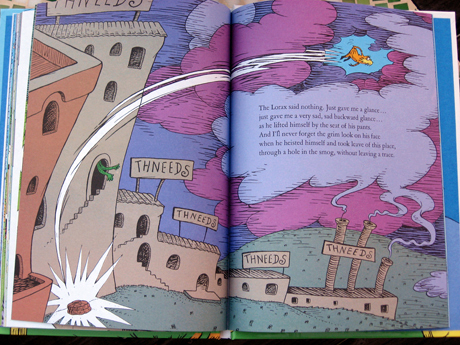
The only thing the Lorax left behind was a small pile of rocks with the word “UNLESS”. Through the years the Once-ler couldn’t figure out what the word meant, but when he sees the small boy and tells the story of the Lifted Lorax he realizes the meaning of the Lorax’s message.
“UNLESS someone like you
cares a whole awful lot,
nothing is going to get better.
It’s not.”

He throws a small seed down to the boy and explains that it is the last Truffula seed. He asks the boy to plant the seed and to give it clean water and grow a whole forest, because Truffula trees are something that everyone needs. He goes on to say that if the forest is protected from axes,
“Then the Lorax
and all of his friends
may come back.”
The end.
ABOUT:
The image above does not actually appear in the book. It is photoshopped, but it does a great job of summarizing the moral of the story. The message is clear and strong; UNLESS you (as in everyone as individuals) make an effort to do something about the environment it is going to continue to be destroyed by corporations making products that advertising makes us feel that we need!
I honestly feel that this is Seuss’ best told story. It is beautifully illustrated and in a way that makes the words that much more powerful, but this doesn’t mean that Seuss cuts down on descriptiveness. He uses both words and illustrations to create a complete world that we, as the readers, are fully immersed in. It also uses more subtle story telling devises. The first thing we see is a sign that says “The Street of the Lifted Lorax” which sparks are interested. The last time we see the Lorax he lifts himself away, leaving the pile of rocks that says UNLESS. The pile of rocks is actually the second major things we see at the beginning of the book, we just don’t get to see the word UNLESS until the very end. This inclusion of some of the final elements of the story in the very beginning creates a full circle feel. The entire book/story is well thought out from beginning to end.
Also, by including just a touch of water in the drip of the faucet and the sad looking cactus on the Once-ler’s tower, Seuss is actually pointing out the lack of water and greenery, which is sharply contrasted by the green hills, beautiful trees and clean pond when we see the land the way it used to be.
“It’s one of the few things I ever set out to do that was straight propaganda…It was also the hardest thing I have ever done, because the temptation was to fall into the same traps the others had fallen into…”
By telling the story from the Once-ler’s perspective Seuss avoids lecturing his audience. He felt that other stories about conservation come off as preachy and full of statistics. Instead, we are being shown an example of how to learn from someone else’s mistake through a fun narrative. Although, the Once-ler is intentionally never fully shown and therefore can not be identified as human, we are meant to relate to his need for material things and more importantly money. By the end of the story we realize the Once-ler may be the bad guy, but then so are we.
Seuss gives us hope by revealing the seed, and a chance for change, represented by the young boy, but he doesn’t leave us completely satisfied. He ends the story saying the creatures “may come back” not “will come back.” This shows us that the damage is done, but that things can be fixed. If he left it completely resolved we would not feel a sense of responsibility that stays with us long after putting the book back on the shelf.
HISTORY:
The Lorax is dedicated to “Audrey”, Seuss’ second wife, and her daughters, “Lark and Lea” “With Love.”
This book did not become super popular until a decade later when environmentalism became a big issue. At first it sold a bit slowly. Seuss readers were a bit confused by it, but Seuss often said it was his favorite book. Eventually it was picked up by many elementary schools to teach conservation. Elliot Elementary school in Lansing, Michigan even started a group called “The Loraxes” that protested cutting down trees, started petitions and planted trees.
Seuss received an award from Keep America Beautiful in November of 1971. The character the Lorax is still used as a symbol for environmentalism 42 years later.
Bill Baily sold logging equipment in Laytonville, California in the late 80’s. In 1989 his son, Sammy, after reading The Lorax in school, claimed his father didn’t love trees anymore. Bill and his wife tried to have The Lorax removed from the elementary reading list because it was anti-logging.
Bill Baily was not the only one who felt attacked by The Lorax. In 1997 Terri Birkett wrote a book called Truax which mimics The Lorax in style. It is about Guardbark, who is a human shaped tree creature, yelling at a logger named Truax. The story comes to the conclusion that logging is needed and useful and that loggers plant new trees so its okay. Guardbark is convinced and flies away leaving the logger surround by smiling creatures.
Here is a great summary of the book:
Seuss’s response to criticism of The Lorax was:
“The Lorax doesn’t say lumbering is immoral. I live in a house made of wood and write books printed on paper. It’s a book about going easy on what we’ve got. It’s anti-pollution and anti-greed.”
Seuss was willing to make one change to The Lorax. There was originally a line that said, “I hear things are just as bad up in Lake Erie.” In 1984, fourteen years after that line was first published, a couple of research associates from Ohio Sea Grant Program asked Seuss to change the line to past-tense since Lake Erie had been cleaned up. In all future publications the line is simply omitted.
OTHER VERSIONS:
In 1972 an animated version of The Lorax was release. Newsweek described it as,
“a hard-sell ecological allegory, stabbing mainly at big business through a deceptively gentle blend of gorgeous colors, superb animation, and a rippling imagery of words and pictures.”
The message was actually softened slightly, but the animation style and plot was kept generally the same. We never see the Once-ler, other than as a pair of green arms, just like in the book.
Seuss claimed his favorite part was at the very end when “Maybe Not” was superimposed over “The End.” Which leaves the feeling of uncertainty that the end of the book has:
“Then the Lorax
and all of his friends
may come back.”
Just recently, in 2012, Universal Studios release The Lorax the motion picture. I always have a hard time with feature length versions (whether they are live action or computer animation) of Dr.Seuss books, because so much of what I love about his books comes from the poetry and the illustrations. I am not going to say I love this movie, but I do think it does a great job of appealing to today’s younger audiences.
 I’m trying not to be a grumpy purist. I’m assuming it helped book sales and turned a whole new generation of young readers into Seuss fans. If that is the case then it’s a good thing. I have a problem with the fact that there is a love story thrown in and that we see the Once-ler and he is very much human. It took some of the mystery out of it, but it is fun and has the same general message of pollution being bad and that we shouldn’t abuse nature. The computer animation is beautifully done and the voice acting is very fun. I would recommend it to people with young children, but I would say it should be quickly followed by an introduction to the book if the child doesn’t already read Dr. Seuss.
I’m trying not to be a grumpy purist. I’m assuming it helped book sales and turned a whole new generation of young readers into Seuss fans. If that is the case then it’s a good thing. I have a problem with the fact that there is a love story thrown in and that we see the Once-ler and he is very much human. It took some of the mystery out of it, but it is fun and has the same general message of pollution being bad and that we shouldn’t abuse nature. The computer animation is beautifully done and the voice acting is very fun. I would recommend it to people with young children, but I would say it should be quickly followed by an introduction to the book if the child doesn’t already read Dr. Seuss.
FAVORITE IMAGE:
I’m kind of cheating on this one. This image does not actually appear in the book, but it is illustrated by Dr. Seuss and I just love the green and purple, with the little Lorax popping out of the tree. I would love to have this as a painting on my wall.
FAVORITE QUOTE:
“Now all that was left ‘neath the bad-smelling sky
was my big empty factory…
the Lorax…
and I.”
This line stuck with me for some reason. It is sort of haunting. After all the production of the thneeds was over the Once-lers family leaves him behind so that he has to face the polluted sky and land all alone. The Lorax doesn’t even speak to him, he also leaves the Once-ler in the mess he’s made.
Thanks for reading,
Jack St.Rebor



